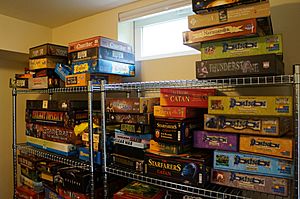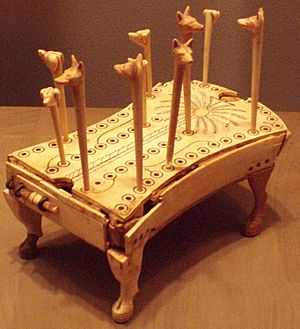Board game facts for kids
A board game is a game usually played with pieces on a special board or area with marked spaces. Players move, place, or trade these pieces following the game's rules. Pieces can be things like money, chips, or pawns. Many board games also use chance, like rolling dice or drawing cards. Some board games have been around for a very long time in different cultures. Famous examples include chess, checkers, backgammon, and go. Other popular board games, like Scrabble and Monopoly, were created more recently.
Chess and most versions of checkers are played on a board with 64 squares, half light and half dark. International checkers uses a larger 10x10 square board.
Contents
The History of Board Games
Ancient Board Games Around the World
Board games have been played in almost every culture throughout history. We know about early board games from old sites, objects, and writings.
Some of the oldest known board games include:
- Senet: This game was found in ancient Egyptian tombs, dating back to around 3500 BC. It is one of the oldest board games ever discovered.
- Mehen: Another game from ancient Egypt.
- Royal Game of Ur: Found in Mesopotamia (modern-day Iraq), this game is about 4,600 years old.
- Chess: This classic game started in India.
- Pachisi and Chaupar: Also from India.
- Go: This strategic game began in China.
- Liubo: Another game that came from China.
- Shax: A game from Somalia.
- Patolli: Played by the ancient Aztec people in Mesoamerica.

Board Games in the United States
In the 1600s and 1700s, people in colonial America mostly worked on farms. They had little free time for games. However, games like checkers, bowling, and card games were played. Some religious groups, like the Pilgrims, did not approve of playing games.
The first board game published in the United States was Traveller's Tour Through the United States in 1822. It was made by F. & R. Lockwood in New York City.
As the U.S. changed from farming to city life in the 1800s, people had more free time and money. Homes became places for fun and learning. Children were encouraged to play board games that helped them learn to read and taught them good behavior.
Early American board games often taught moral lessons. For example, The Mansion of Happiness (1843) guided players along a path of good and bad actions, leading to a "Mansion of Happiness."
Making board games became easier and cheaper in the mid-1800s. New printing methods, like chromolithography, allowed for colorful images at lower prices. Games could cost as little as 25 cents.
In 1860, a game called The Checkered Game of Life became very popular. It rewarded players for everyday activities like going to college, getting married, and becoming rich. This game was important because it focused on worldly success instead of just religious lessons. It sold 40,000 copies in its first year.
Games like Game of the District Messenger Boy, or Merit Rewarded (1886) showed how people could become wealthy. These games suggested that getting rich could improve your social status. This idea of competitive wealth-building in games led to Monopoly in 1935. Monopoly became one of the most successful board games in U.S. history.
The period from the 1880s to the 1920s is often called "The Golden Age" of board gaming in America. Mass production made games cheaper and more available, boosting their popularity.
Board Games in the 21st Century
Since the late 1990s, board games have become much more popular. The Internet has helped, making it easier for people to find out about new games and connect with other players. Around the year 2000, the board game industry started to grow quickly. Many new games were created and sold to a growing audience worldwide.
In the 2010s, many people started calling this time a new "Golden Age" for board games. Places like board game cafes, where people can play games together, have also become very popular, especially in countries like China.
How Board Games Work: Luck, Strategy, and Diplomacy
Some board games rely completely on a player's skill. For example, chess is all about strategy and planning. Other games, like Candy Land or Snakes and Ladders, are purely about luck. Players don't make any decisions; the game is decided by chance.
Many games combine both skill and luck. In games like backgammon, Monopoly, or Risk, a player might have bad luck. However, over many games, a skilled player will usually win more often. The luck element can make games more exciting and lead to different strategies. Players might need to think about things like expected value and risk management.
Luck can be added to a game in several ways:
- Dice: Rolling dice is a very old way to add randomness. Dice can decide how many spaces a player moves, how well forces do in battle, or what resources a player gets.
- Cards: Games like Sorry! use shuffled decks of special cards to create randomness.
- Random Selection: Scrabble uses randomly picked letters. Other games might use spinners or timers.
German-style board games often have less luck involved compared to many North American board games.
Another important part of some games is diplomacy. This means players make deals or agreements with each other. Negotiation usually happens in games with three or more players. For example, in Catan, you might try to convince other players to trade resources with you instead of your opponents. In Risk, players might team up against others.
In some games, called "perfect information" games (like chess), every player knows everything about the game's situation. But in other games, like Stratego, some information is hidden from players. This makes it harder to find the best move and might involve guessing what opponents have.
Images for kids
-
The board game Monopoly is licensed in 103 countries and printed in 37 languages.
-
Young girls playing a board game in the Iisalmi, Finland, library in 2016
-
Hounds and Jackals (Egypt, 13th Dynasty)
-
Tomb models of two men playing a game of liubo, Han dynasty
-
Han dynasty glazed pottery tomb figurines playing Liubo, with six sticks laid out to the side of the game board
See also
 In Spanish: Juego de tablero para niños
In Spanish: Juego de tablero para niños















